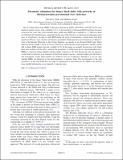| dc.contributor.author | Vitale, Salvatore | |
| dc.contributor.author | Evans, Matthew J | |
| dc.date.accessioned | 2017-06-02T23:13:17Z | |
| dc.date.available | 2017-06-02T23:13:17Z | |
| dc.date.issued | 2017-03 | |
| dc.identifier.issn | 2470-0010 | |
| dc.identifier.issn | 2470-0029 | |
| dc.identifier.uri | http://hdl.handle.net/1721.1/109577 | |
| dc.description.abstract | Parameter estimation for binary black holes with networks of third-generation gravitational-waveaThe two binary black hole (BBH) coalescences detected by LIGO, GW150914, and GW151226, were relatively nearby sources, with a redshift of ∼ 0.1. As the sensitivity of Advanced LIGO and Virgo increases in the next few years, they will eventually detect stellar-mass BBHs up to redshifts of ∼ 1. However, these are still relatively small distances compared with the size of the Universe, or with those encountered in most areas of astrophysics. In order to study BBH during the epoch of reionization, or black holes born from population III stars, more sensitive instruments are needed. Third-generation gravitational-wave detectors, such as the Einstein Telescope or the Cosmic Explorer, are already in an advanced R&D stage. These detectors will be roughly a factor of 10 more sensitive in strain than the current generation, and they will be able to detect BBH mergers beyond a redshift of 20. In this paper we quantify the precision with which these new facilities will be able to estimate the parameters of stellar-mass, heavy, and intermediate-mass BBHs as a function of their redshifts and the number of detectors. We show that having only two detectors would result in relatively poor estimates of black hole intrinsic masses: a situation improved with three or four instruments. Larger improvements are visible for the sky localization, although it is not yet clear whether BBHs are luminous in the electromagnetic or neutrino band. The measurement of the spin parameters, on the other hand, does not improve significantly as more detectors are added to the network since redshift information is not required to measure spin. detectors | en_US |
| dc.description.sponsorship | National Science Foundation (U.S.) | en_US |
| dc.description.sponsorship | Laser Interferometer Gravitational Wave Observatory | en_US |
| dc.publisher | American Physical Society | en_US |
| dc.relation.isversionof | http://dx.doi.org/10.1103/PhysRevD.95.064052 | en_US |
| dc.rights | Article is made available in accordance with the publisher's policy and may be subject to US copyright law. Please refer to the publisher's site for terms of use. | en_US |
| dc.source | American Physical Society | en_US |
| dc.title | Parameter estimation for binary black holes with networks of third-generation gravitational-wave detectors | en_US |
| dc.type | Article | en_US |
| dc.identifier.citation | Vitale, Salvatore, and Matthew Evans. “Parameter Estimation for Binary Black Holes with Networks of Third-Generation Gravitational-Wave Detectors.” Physical Review D 95.6 (2017): n. pag. © 2017 American Physical Society | en_US |
| dc.contributor.department | Massachusetts Institute of Technology. Department of Physics | en_US |
| dc.contributor.department | MIT Kavli Institute for Astrophysics and Space Research | en_US |
| dc.contributor.mitauthor | Vitale, Salvatore | |
| dc.contributor.mitauthor | Evans, Matthew J | |
| dc.relation.journal | Physical Review D | en_US |
| dc.eprint.version | Final published version | en_US |
| dc.type.uri | http://purl.org/eprint/type/JournalArticle | en_US |
| eprint.status | http://purl.org/eprint/status/PeerReviewed | en_US |
| dc.date.updated | 2017-03-28T22:00:04Z | |
| dc.language.rfc3066 | en | |
| dc.rights.holder | American Physical Society | |
| dspace.embargo.terms | N | en_US |
| dc.identifier.orcid | https://orcid.org/0000-0003-2700-0767 | |
| dc.identifier.orcid | https://orcid.org/0000-0001-8459-4499 | |
| mit.license | PUBLISHER_POLICY | en_US |
